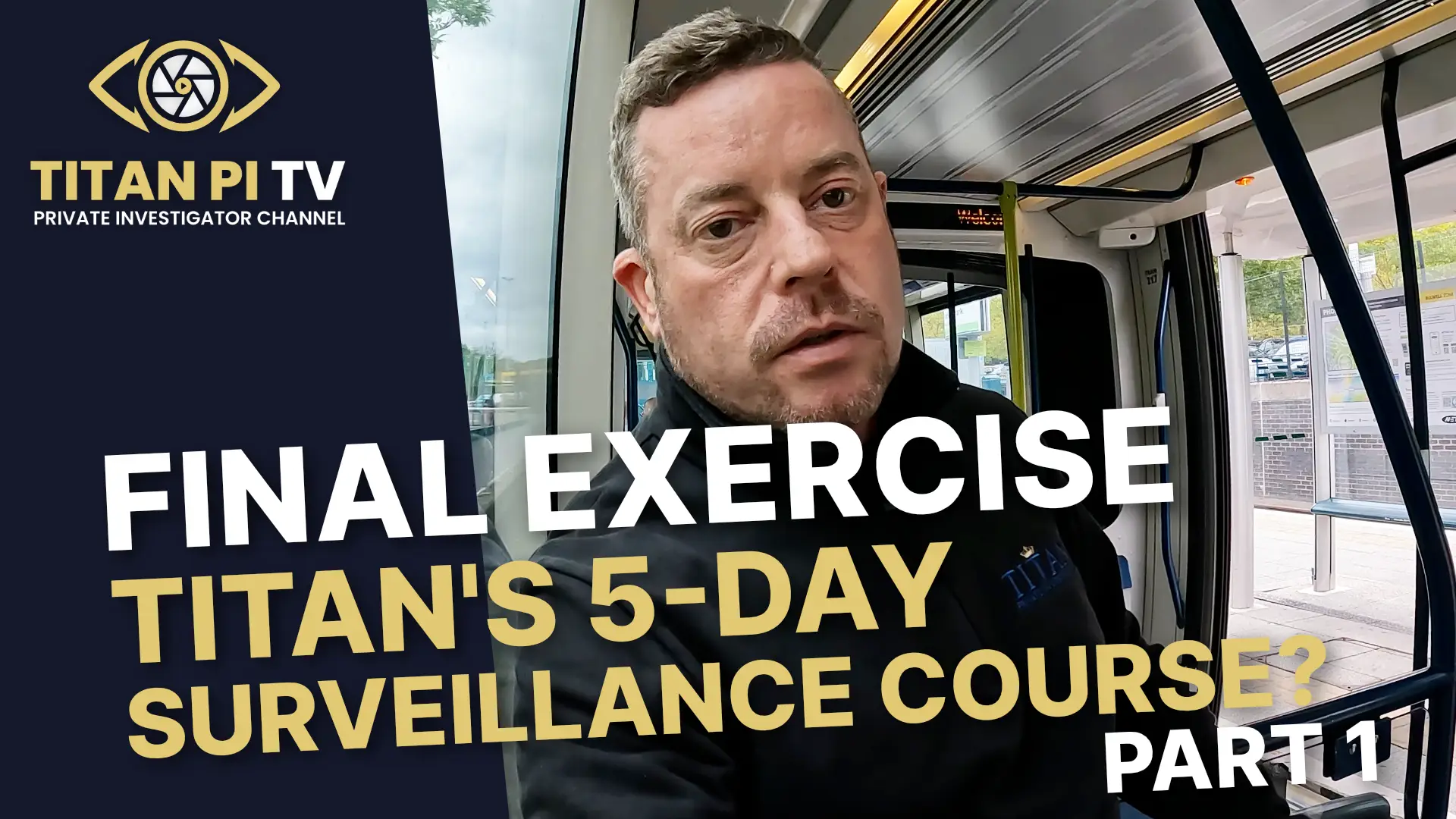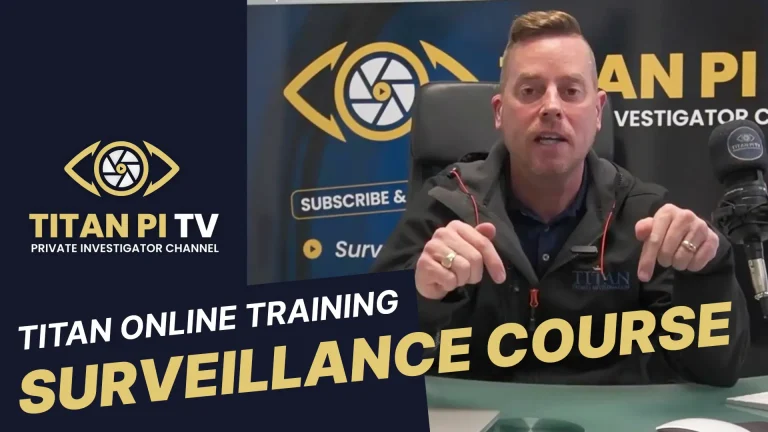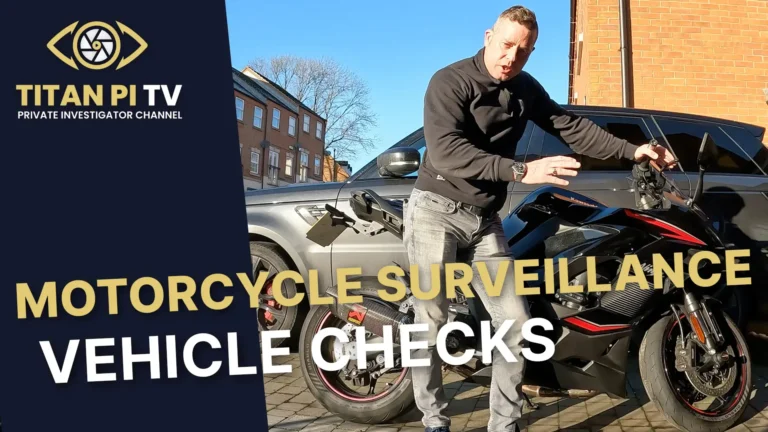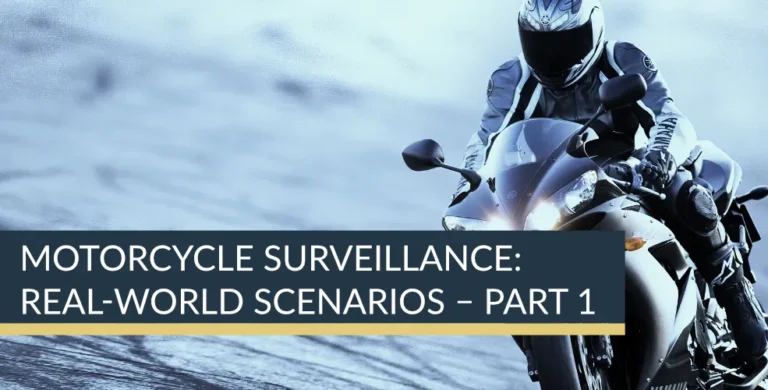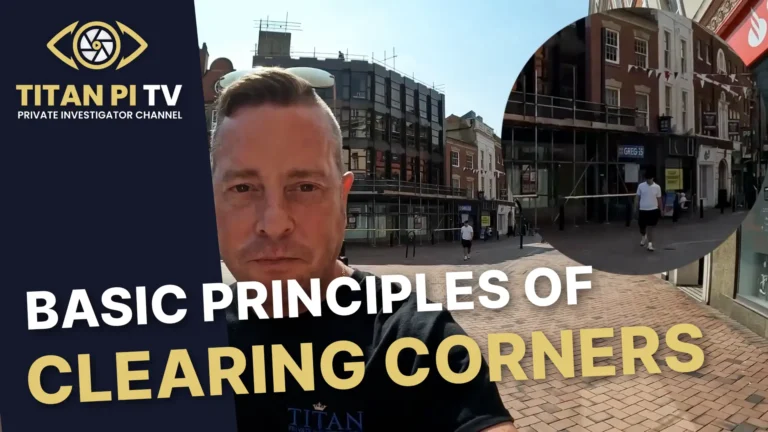Final Exercise – Titan’s 5-Day Surveillance Course Part 1
Titan’s 5‑Day Surveillance Course reaches its climax
Titan PI TV returned this week with a high‑stakes field episode documenting the culmination of Titan Private Investigation’s renowned five‑day Surveillance Course. Presented by host and Managing Director, Simon Henson, “Final Exercise – Titan’s 5‑Day Surveillance Course Part 1” takes viewers behind the scenes as trainees transition from classroom techniques to real‑world execution under pressure. The result is an instructive, fast‑paced and often tense look at how modern surveillance is planned, coordinated and delivered by a professional team in a live environment.
From an early morning briefing in Derby to complex foot and mobile surveillance through multi‑storey car parks, shopping centres, trams and city streets, the episode showcases the discipline and orchestration required to keep a subject under constant control without compromising cover. It also underlines Titan’s training philosophy: rigorous standards, realistic scenarios and instructor oversight that replicates the tempo and unpredictability of operational deployment.
A leaner team steps up
From an original cohort of 12, the final exercise begins with 10 trainees. Simon notes the attrition without melodrama: two candidates will return for further development, having shown potential but requiring more support before passing. It’s a hallmark of Titan’s approach—quality over quantity—ensuring that those who complete the programme are ready for the demands of live investigations.
With the reduced team assembled, the morning opens at a Premier Inn on the Wyvern in Derby. The subject vehicle is located; the subject himself is inside the premises. The team has already conducted their briefing, walking through the operational order using Titan’s standard framework—intention, information, method and further elements that structure how a deployment unfolds. The language is crisp, the order of operations clear. Everyone knows their roles before the first move is made.
“Good lift, good day”
In surveillance, the opening manoeuvre—the lift—often dictates the flow of everything that follows. “Good lift, good day,” Simon reminds viewers, invoking a mantra drilled into every operative. A poor lift sets the team on the back foot and complicates the rest of the day. To mitigate risk, the team sanitises the hotel car park, identifies and secures the key exits, positions vehicles for strategic coverage, and inserts a foot unit inside to watch the subject.
They also deploy a tracker to the subject’s vehicle—an essential safety net that allows technical coverage to backstop any temporary loss of visual contact. The operation hinges on two parallel disciplines: human surveillance craft and technical assurance. If the lift falters, technology can prevent a total loss; if the technology fails, disciplined foot and mobile teams must still carry the day.
On this occasion, the lift is textbook. The tracker is fitted discreetly while the subject remains under firm control. In the end, it isn’t needed—the fieldcraft proves strong enough to maintain continuous observation—but its presence reassures the command team that if the unexpected occurs, they can recover quickly.
From car park to city centre: orchestrating foot surveillance
With the subject departing the hotel, the team follows to a multi‑storey car park connected to a shopping centre. Henson narrates in real time as the trainees execute the next phase: declare the location correctly, all‑enter the structure, deploy foot units and cover the egress routes. This is where operational choreography becomes decisive. In enclosed environments like car parks, lifts and escalators can easily expose a surveillance team. The tactic is to avoid tailgating the subject up and down verticals. Instead, teams pre‑position across floors and exits, keeping the subject “under control” while minimising proximity that might raise suspicion.
Inside the centre, the subject pops into The Bear, a coffee shop. The team implements “VINO” coverage—visual, in‑near‑side, off‑side—ensuring eyes on the subject from multiple angles while avoiding clustering. From there, the subject moves through various shops and into Marks & Spencer, a multi‑level department store. The trainees correctly identify the building type, assign floors, and establish an eyeball—one operative responsible for the continuous visual—while others distribute strategically to avoid being funnelled into lifts and escalators with the subject.
The discipline holds. Even as the subject rides lifts between levels and rides escalators, the coverage is layered rather than linear. It’s a subtle distinction that marks professional surveillance: not following the subject like a shadow, but shaping the space so the subject remains encircled without direct tailing.
Transition to mobile: controlled cover on the M1
As the subject returns to his vehicle and departs the car park, the exercise evolves into a mobile phase. The convoy transitions onto the M1 northbound near Junction 25. Over radio, the team communicates calmly and precisely—lane position, speed, and the number of vehicles for cover—maintaining distancing to blend naturally with traffic. The aim is clear: keep the subject in view without creating patterns that would attract attention.
Again, Simon is careful not to distract the team with commentary. It’s a subtle nod to Titan’s training ethos: once the operation is live, instructors manage the risk and trajectory, but they allow trainees to manage the moment.
Multimodal challenge: park and ride, tram, and a city entry
The subject’s decision to stop at a park and ride halfway to Nottingham adds a layer of complexity. He moves to public transport—a tram—forcing an immediate reconfiguration. Foot teams deploy onto the tram; vehicles are tasked to shadow the tram’s route from the road network. This “shadow and support” method preserves options: if the subject alights to meet a contact, switch transport, or enter a vehicle, the team can respond without delay.
On the tram, the trainees execute a “cocoon” formation. With the subject seated in the middle carriage and the tram busy, only one operative takes the true eyeball position in the same carriage—minimising exposure—whilst additional team members occupy the carriage ahead and the one behind. The result is 360‑degree resilience: if the subject moves forward or back, coverage collapses in without crowding him. It’s a sophisticated technique to manage public‑transport surveillance in tight, highly observable environments.
Nottingham city centre: department stores, cafés and controlled proximity
Arriving in Nottingham city centre, the subject enters the Victoria Centre and moves directly into shops. The team follows the same doctrine from Derby: one operative holds a visual; others establish near‑side and off‑side cover. The next test is John Lewis, a multi‑floor department store that challenges spatial awareness and discrete communication.
Here, Titan’s methodical approach comes to the fore. The team correctly identifies the store type, declares all‑enter, and divides coverage by floor. The subject heads straight up to Level 3—potentially a stress test—and the team adapts smoothly. Rather than bunching around the subject on lifts or escalators, they pre‑position and hand off visuals across levels. When the subject later moves down to Level 2, coverage remains consistent, avoiding the classic mistake of incessant up‑and‑down trailing.
A café stop further tests patience and positioning. One operative takes close control inside; another maintains a line of sight; near‑side and off‑side positions are held outside with multiple vantage points available through large window frontages. When the subject goes to the toilet—a common scenario that can wrong‑foot unseasoned teams—operatives remain calm, keeping control from outside whilst maintaining awareness of exits and flow back into the café.
Throughout, Simon’s commentary is a blend of coaching and critique, but the tone remains measured. The team is “pulling together”, dealing with each phase “nicely”, and treating the scenario with the seriousness of a live operation, intention from the outset.
What the episode reveals about Titan’s training philosophy
- Realism under supervision: The exercise mirrors operational constraints—mixed environments, public transport, changing pace—without compromising public safety or the subject’s privacy beyond the training brief. Instructors supervise closely while letting trainees make decisions and own their outcomes.
- Structure first, flair later: The consistent use of frameworks—operational orders, VINO, all‑enter declarations, floor coverage plans—creates predictable, repeatable behaviours under stress. This structure is what enables the team to flex without losing cohesion.
- Technical assurance, human primacy: The tracker deployment is an instructive touchstone. It’s an insurance policy, not the primary strategy. Titan’s emphasis remains on situational awareness, observation discipline and team coordination. Technology supports, it doesn’t supplant.
- Communication is the backbone: Whether relaying lane positions on the motorway, declaring department store floors, or announcing all‑enter/all‑exit moments, the radio procedure is calm, concise and purposeful. It’s a running lesson in how language and timing underpin operational success.
- Professional distance: The trainees demonstrate the difficult art of staying close enough to control outcomes while distant enough to remain unremarkable. From cafés to escalators, their positioning is thought‑through rather than reactive.
Why this matters for clients and aspiring operatives
For clients, episodes like this offer a transparent window into how Titan protects their interests in the field. Surveillance is not Hollywood bravado; it’s systems thinking in motion, underpinned by legality, ethics and professional restraint. The measured pace, layered planning and fail‑safes seen here are what produce clean evidence and reduce the risk of compromise.
For aspiring operatives, the episode underscores that passing Titan’s course means more than learning tips and tricks. It’s about absorbing a methodology: meticulous briefings, structured coverage, intelligent use of environment, and thoughtful communication. It’s also about stamina—moving from car parks to trams to city centres without letting standards slip.
The scorecard so far
- Lift: Textbook. Subject controlled; tracker deployed discreetly; not required during the run thanks to strong visual coverage.
- Car park to shopping centre transition: Clean declarations and deployment. VINO principles applied; exits covered.
- Department stores: Correct identification and floor coverage, avoiding exposure on lifts and escalators. Effective handovers.
- Motorway mobile: Disciplined spacing, accurate radio calls, natural cover vehicles.
- Park and ride to tram: Smart split between foot cocoon on-board and vehicle shadowing along the route.
- Nottingham city centre: Continued application of principles under crowd pressure. Café phase managed professionally, including toilet break management.
It’s a strong performance—particularly given the attrition earlier in the week—suggesting that the remaining trainees have internalised the fundamentals and can operate coherently as a team.
Looking ahead to Part 2
As Henson hints, the final exercise is designed to be the closest simulation to a live investigation that Titan can responsibly run in training. Part 1 demonstrates controlled competence across varied terrain. The open question for Part 2 is whether the team can sustain standards when the route, tempo or subject behaviour becomes more unpredictable—perhaps a rapid transport switch, a contact meet, or an attempted anti‑surveillance manoeuvre.
Titan PI TV’s format—mixing real‑time narration with instructional framing—makes these episodes compelling not only for investigators and security professionals, but also for clients and viewers curious about what ethical, professional surveillance looks like in practice. There is no glamorisation here—just craft, discipline and accountability.
Watch, listen and stay informed
New episodes of Titan PI TV are available on YouTube, with audio versions available via the Titan PI TV podcast wherever you get your podcasts. For those following the five‑day course series, this instalment marks an inflection point: the transition from learning to proving. Part 2 promises additional pressure and complexity—and, no doubt, more lessons in the art and science of staying close, staying calm and staying in control.
As Simon Henson says with a smile when everything clicks into place: happy days.
What’s Next on Titan PI TV?
Titan PI TV continues to grow steadily, with over 2,800 subscribers and counting—a testament to the appetite for straight-talking guidance in a complex field. If you found Henson’s insights useful, subscribe to the channel to catch future episodes. New content drops every Friday at 3:00 pm, offering grounded advice for investigators, agency owners, and professionals who work with them.
Thank you for reading, watching, or listening to this week’s blog post on Titan PI TV. For more expert advice and behind-the-scenes insights, subscribe to Titan PI TV on YouTube or download the Titan PI TV podcast wherever you get your podcasts. If you found this information helpful, please give us a thumbs up and subscribe to our channel. Stay tuned for more insights into the world of private investigations. Until next time, stay safe and keep learning!
Titan PI TV: Uncovering the Truth, One Investigation at a Time.

